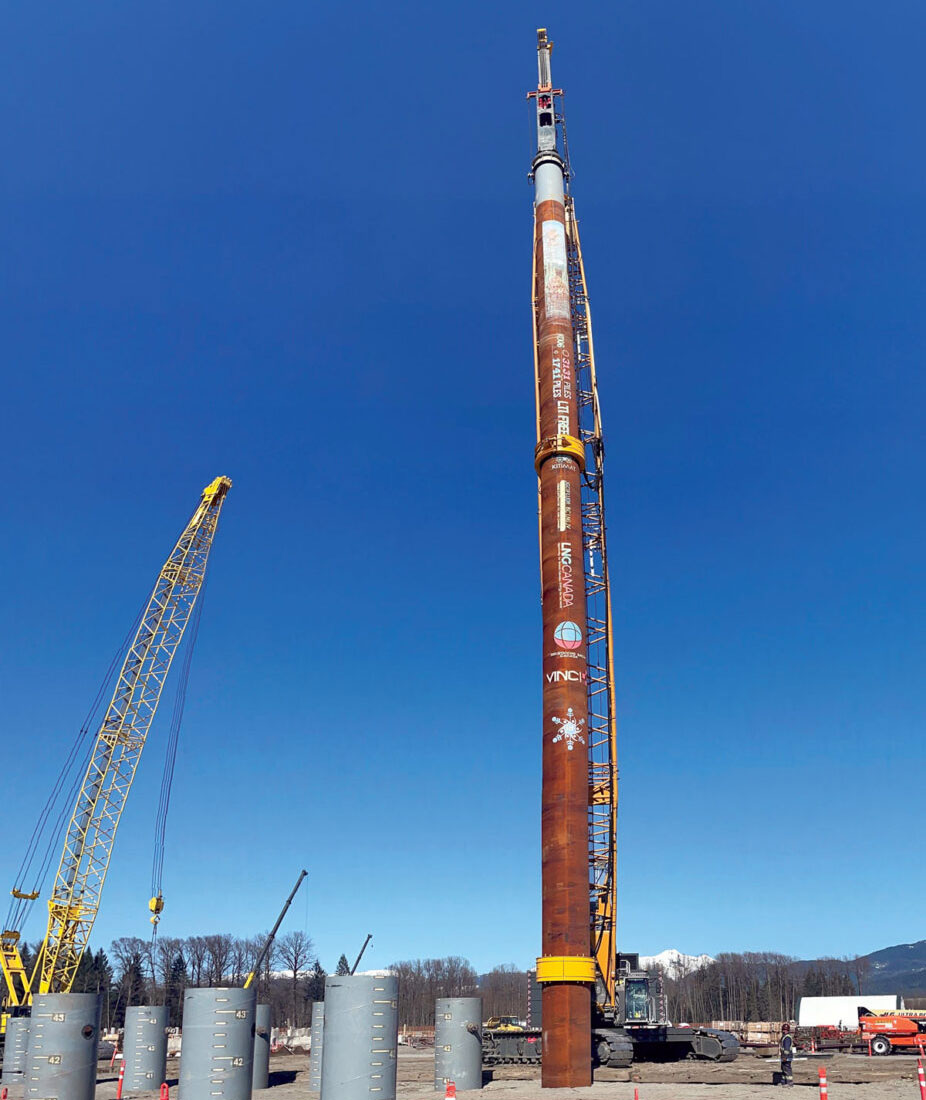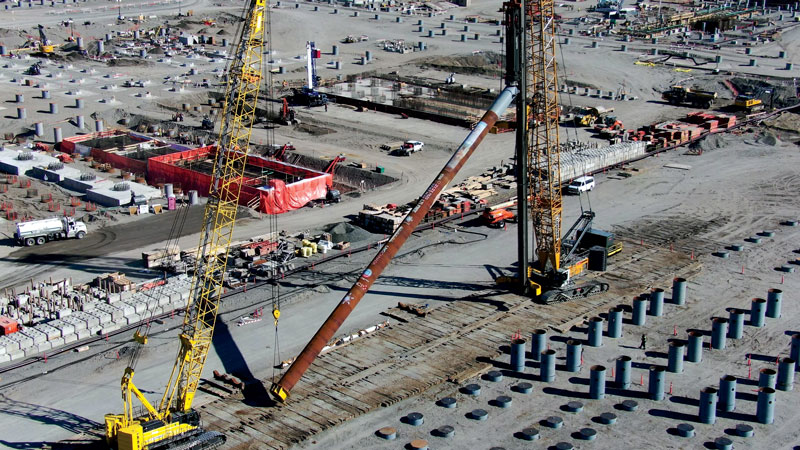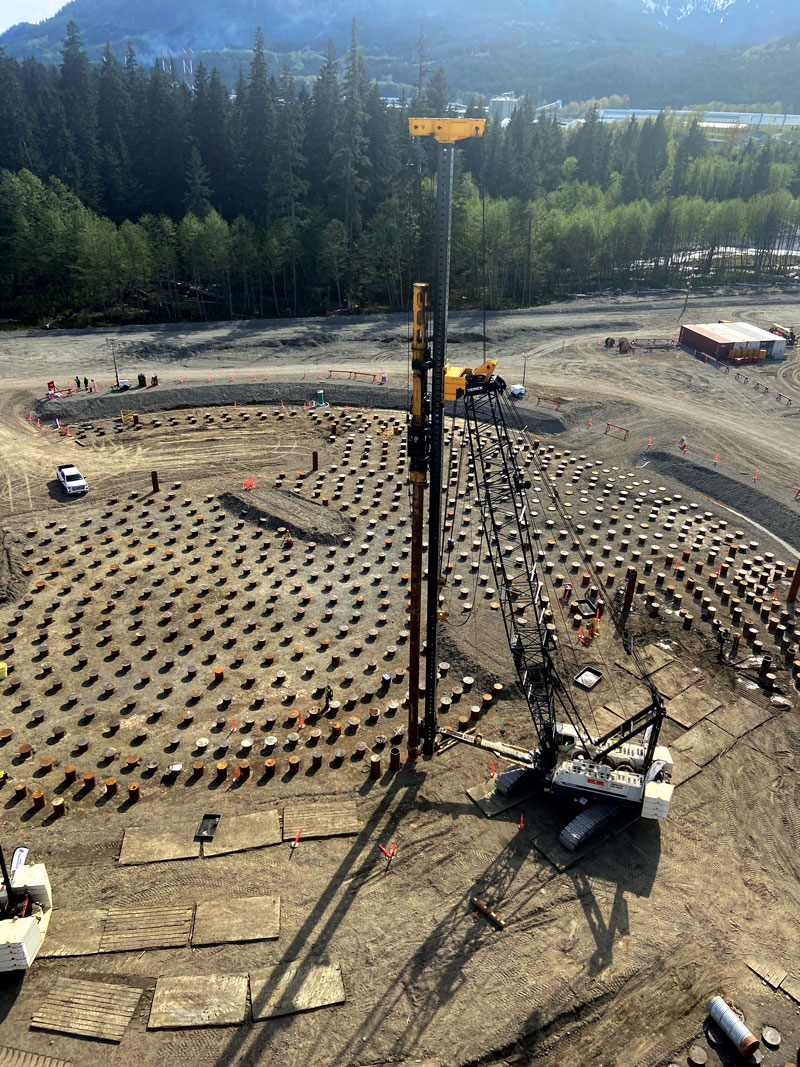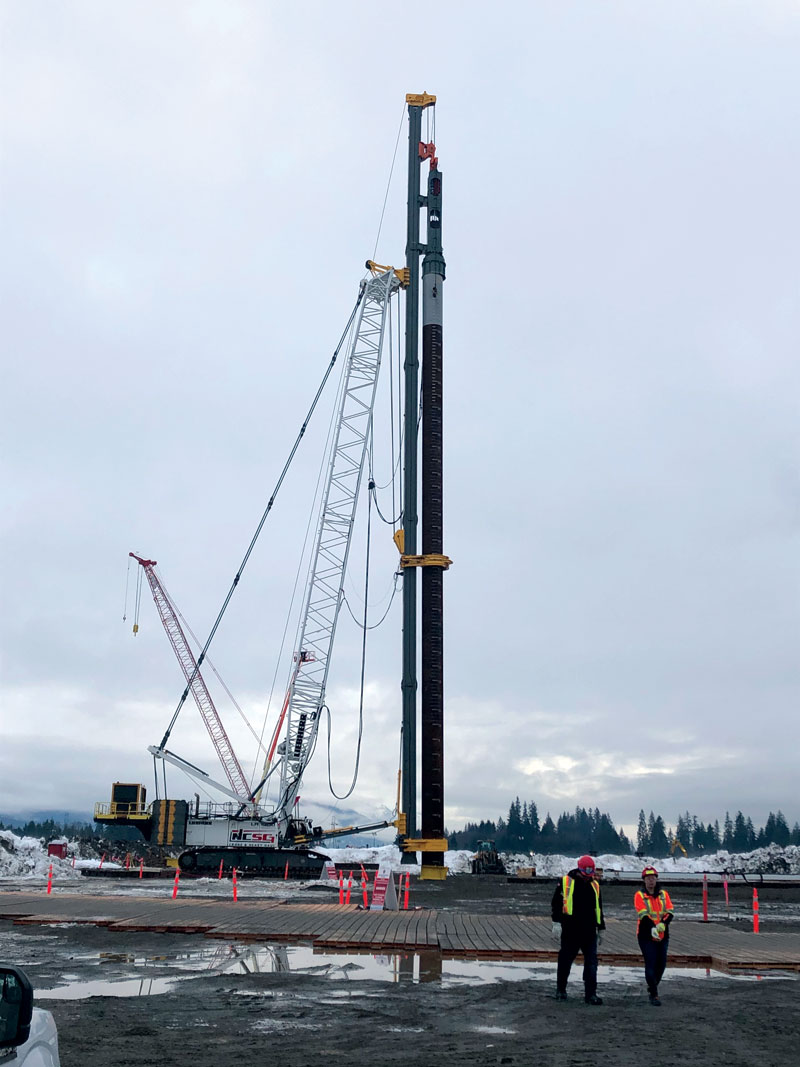
Surrounded by the majestic Coast Mountains in northern British Columbia, at the end of a fjord-like body of water that extends 142 kilometres (88 miles) to the Pacific Ocean and is often isolated by harsh weather conditions, Soletanche Bachy Canada (SBC) in partnership with Berminghammer Foundation Equipment has demonstrated the ingenuity and strength of the Canadian piling industry as they tackled and successfully completed a massive infrastructure installation.
LNG Canada is a joint venture between Shell, Petronas, PetroChina Company Limited, Mitsubishi Corporation and Korea Gas Corporation to build a liquefied natural gas (LNG) plant and export terminal in the deep-water port on the B.C. North Coast in the District of Kitimat, on the traditional territory of the Haisla Nation. The $40 billion project covering 400 hectares (1,000 acres) of land is being designed and built by JGC Fluor BC LNG JV (JFJV). Scheduled to open by mid-decade, the plant will consist of a LNG loading line, marine terminal, LNG processing units, storage tanks, rail yard, water treatment facility and flare stacks.
The main contractor, JFJV, engaged SBC to carry out the base foundation piling work with a very short timeline from December 2019 to April 2021. Fifteen months to mobilize equipment, materials and workers and drive almost 7,000 piles was a huge commitment. However, time wasn’t the only challenge that SBC would be facing before the project was finished.
Piles that went to great lengths
“The design, seismic considerations, material availability and construction constraints all led to the selection of driven piles,” said Alexandre Beauvilain, project director, major projects at SBC. As a project requirement, only fixed leads were permitted for driven pile installation. Well-suited to level jobsites with few obstructions and fast positioning of the lead, this system was necessary to deliver the precise control needed for the extremely tight grid that had been designed by the engineers.
Although, these weren’t to be just any driven piles; these were going to be some of the longest single-length driven land-piles in North America at five feet in diameter, 144 feet in length and weighing 45 tons each.

David Zanchetta, P.Eng., sales and services at Berminghammer said, “When envisioning this project back in 2016, they were always looking for very long piles to achieve capacity for Trains 1 and 2 of the plant. The reasons to go long instead of splicing were both time and money. Welding a six-foot-diameter, one-inch-thick steel pipe to another section on top would take about three days to accomplish for each pile. The schedule would have been so very long – plus the money spent mobilizing the crane and waiting for all the welding – [it was] out of the question. Putting them into the ground in one piece was hugely advantageous.”
Equipment to do the job
Typically, traditional pile driving rigs can’t go to the lengths that this project demanded without splicing. However, Berminghammer came up with the solution.
“Just before talking with the designers on this project, we’d designed a lead for a company out in California that could go to 186 feet,” said Zanchetta. “It was a totally different application for drilling using a Continuous Flight Auger (CFA), but we figured there was no reason not to take a look at using the same lead for these full-length driven piles.” The Berminghammer H36 VTL system on a 300-ton crane was the answer.
The virtual safety program was developed in 2018 by the SB quality, environmental and safety team alongside parent company Vinci Construction.
“We had to make a few custom alterations; the hammer cap needed to be detachable from the hammer and that took a while to configure,” said Zanchetta. “But the lead columns were already designed, and it became a matter of fabricating everything and getting it out there and working.
“The end result was a 186-foot-tall H36 VTL system mounted to the Liebherr LR-1300 crane. The system featured a number of innovative features, including custom rigging for the tandem pile lift and a one-armed mid-gate to improve the routing of the extremely long hydraulic hoses.”
Berminghammer sent four of these specially designed systems to the site, working side by side to get the thousands of piles into the ground as quickly and safely as possible.
On site and in position
The steel piles came by boat, off-loaded and stockpiled directly onto the site.
“Then we had to get them from the laydown area to the installation area,” said Beauvilain. “First, conventional trucks with pipe racks were used, but the length made it difficult to take the corners and the supply demand, driven by the rate of installation, quickly proved to be impacting the critical path. We decided to deploy a self-propelled motorized transporter capable of safely transporting two piles at once in very tight areas. That worked very well.”

“Lifting the pile into the vertical was a big challenge,” said Zanchetta. “We ran some stability analysis and knew we needed to put the lead on a really big crane; the hammer would have to be gigantic. Trying to control lifting piles that ranged from 24 inches to five feet in diameter by 144-feet-long – massive pieces of steel – presented its own challenges.”
“We did more than 3,000 critical lifts on the job,” said Beauvilain. “The successful method we chose was a dual lift, using two cranes, one at either end of the pile. At onset, the load was shared between the driving crane and the tailing crane, with the tailing crane walking towards the driving crane until the pile was held vertical.
“We went from signature in December 2019 to production on the ground by the end of January 2020, an incredibly fast mobilization period. That first pile took nearly three hours to unload and hoist into the vertical position, and the pile driving time was relatively long. A steep learning curve was followed, and in short order the entire process was optimized and running like a well-oiled machine.

“You could say that although every step in the installation process was similar to standard pile driving, the completely different scale meant innovation and professionalism was key to the success of the project. Lengths, weights, forces were all enormous, and as such everything had to be redesigned and rethought from the cranes to the rigging, right down to the work platforms.”
Over the course of the next four months, the crew loaded, transported, lifted and drove almost 7,000 piles – more than 100 kilometres (60 miles) of pipe – under extreme weather conditions in a remote area and with no time lost incidents, all the while meeting or exceeding target production rates. The project is additionally incredible when considering the impact of Covid-19, including a public health order to suspend works temporarily in January 2021, and delays to the supply chain.
Achieving real safety through virtual training
“We did our best to develop safe lift and work plan procedures, had a lot of review and consultation with the workforce and eventually ended up with a refined version that worked very well with no lost time incidents throughout the entire 150,000-plus man-hours of the project,” said Beauvilain.
Part of that safety success was because of the new virtual reality safety training developed by Soletanche Bachy (SB). The virtual safety program was developed in 2018 by the SB quality, environmental and safety team alongside parent company Vinci Construction. SBC’s health, safety and environment team adapted the existing version, which had never been used in Canada, to the LNG Canada site and implemented the training at Kitimat. The tool is especially effective for new employees or people not used to being on a jobsite.
Typically, traditional pile driving rigs can’t go to the lengths that this project demanded without splicing. However, Berminghammer came up with the solution.
“We’re quite proud of this safety training program, as it can be used to train people in all kinds of positions using new virtual reality software technology, tailored to a specific project environment,” said Beauvilain. “It’s almost like being in a movie or video game scenario, where people move through the landscape of an actual project, experiencing the project environment, all from the safety of a controlled office environment. The idea is to not only show unsafe situations or at-risk behaviours, but also good practices on jobsites.”
In the end, the project team was particularly proud of its accomplishments, notably its numerous innovative solutions to various challenges.
“There was a great comradery established on the project,” said Beauvilain. “Partly because of the remoteness of the location, partly because of importance of the project and its success. We took care of our crews, and our crews took care of us. A feeling of mutual pride was apparent, and this resulted in building a good work environment and we received many safety awards from the client and gave many internally, as well.”
On April 20, 2021, SBC installed the final pile on the project, the first major milestone of the LNG Canada project in Kitimat. It was a day to celebrate the ingenuity and hard work of everyone involved in one of the largest energy megaprojects ever undertaken in Canada.
This article originally appeared in PileDriver Issue 6 2021 and is reproduced here with permission.